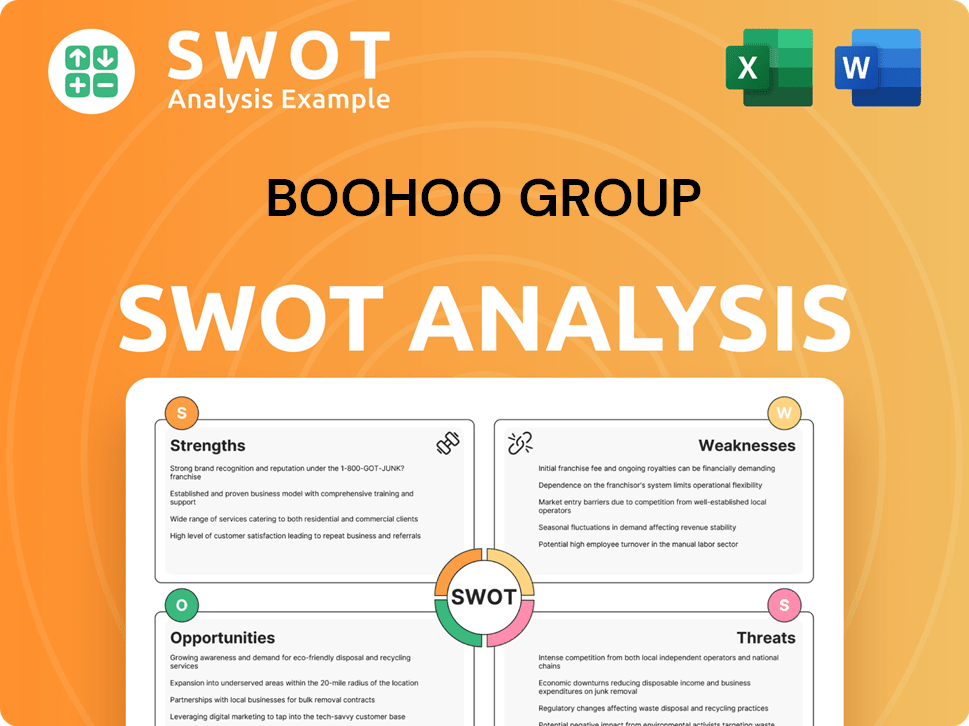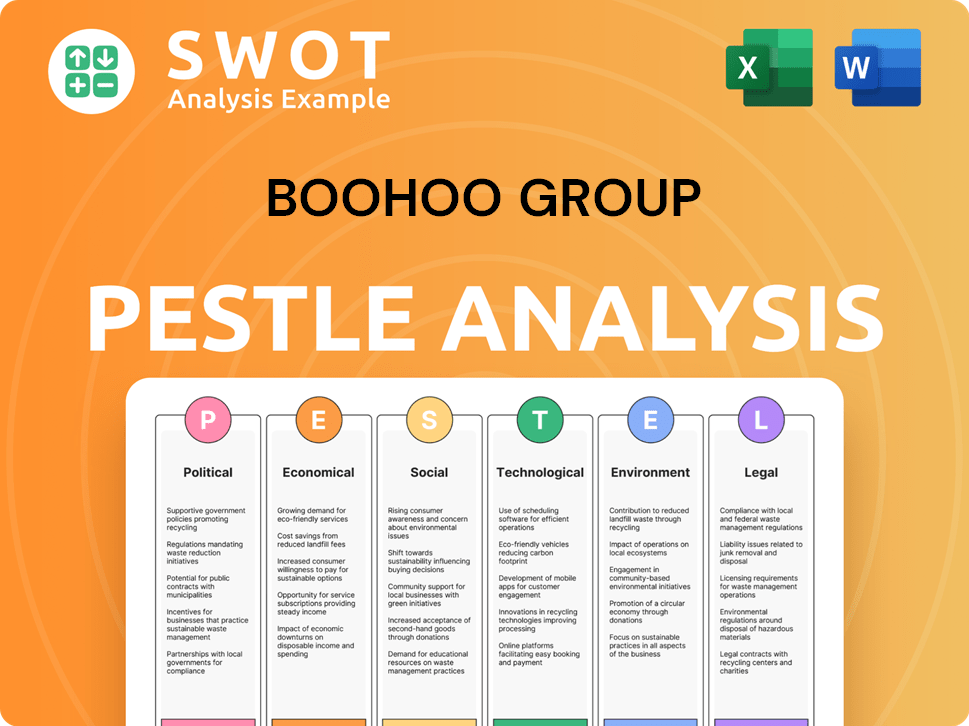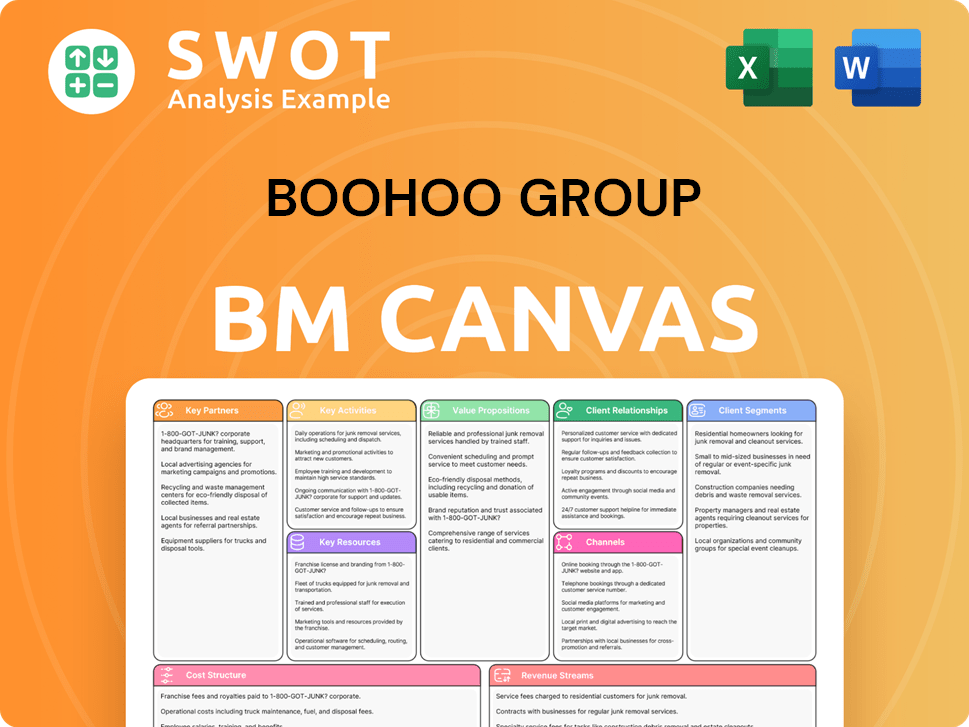boohoo group Bundle
Can Boohoo Group Outmaneuver Its Rivals in the Fast Fashion Arena?
The fast fashion industry is a whirlwind of trends and competition, but how does Boohoo Group PLC, a major player in online retail, stack up? Founded in 2006, Boohoo has rapidly evolved, building a multi-brand empire. This analysis delves into the boohoo group SWOT Analysis to understand its position in a dynamic market.

Understanding the boohoo group competitive landscape is crucial for investors and strategists alike. This exploration offers a deep dive into the boohoo market analysis, examining its key competitors and evaluating its strengths and weaknesses. From analyzing boohoo group key competitors 2024 to assessing its growth strategy, this report provides actionable insights into Boohoo's future outlook within the fast fashion industry.
Where Does boohoo group’ Stand in the Current Market?
Boohoo Group operates as a multi-brand online retailer, focusing on the fast fashion industry. It offers clothing, shoes, accessories, and beauty products to a global customer base. The company's business model centers on providing trendy, affordable fashion, primarily through its online platforms.
The value proposition of Boohoo Group lies in its ability to quickly adapt to fashion trends and offer a wide variety of products at competitive prices. This strategy is supported by a strong online presence and efficient supply chain management. The company's diverse portfolio of brands caters to different segments of the market, enhancing its market reach and appeal.
As of February 29, 2024, the company reported revenue of £1.46 billion. However, in the six months ending August 31, 2024, revenues further declined by 15% year-on-year to £619.8 million. The company's market capitalization as of June 2025 is £0.30 billion. The company is undergoing a strategic review to maximize shareholder value.
The UK remains the largest market for Boohoo Group, accounting for 63.1% of total sales in FY2023. The company has a significant online presence, targeting a global customer base. Boohoo Group's market share is influenced by its ability to compete within the fast fashion industry and its online fashion retailers.
Boohoo Group's portfolio includes five core brands: boohoo, boohooMAN, PrettyLittleThing (PLT), Karen Millen, and Debenhams. It also operates eight labels. The diversification of brands allows Boohoo Group to cater to various customer segments, enhancing its overall market position and competitive landscape.
In H1 FY25, Boohoo Group reported a loss before tax of £147.3 million. The 'Youth Brands' experienced a decline in GMV pre-returns of 16% in H1 FY25. Debenhams marketplace showed significant growth, with GMV pre-returns increasing over 170%. Karen Millen also delivered positive GMV growth in H1 FY25, impacting the company's financial performance.
Boohoo Group is currently undergoing a strategic review focused on digital transformation and brand diversification. This strategic shift aims to improve shareholder value and adapt to the evolving fashion market. The company's growth strategy includes an emphasis on online presence and supply chain optimization.
The competitive landscape for Boohoo Group is influenced by its ability to compete with other online fashion retailers. The company's market position is affected by its financial performance, brand portfolio, and strategic initiatives. The fast fashion industry is highly competitive, requiring continuous adaptation and innovation.
- Declining revenues and a loss before tax in H1 FY25.
- Growth in the Debenhams marketplace, indicating diversification.
- Strategic review focused on digital transformation and brand diversification.
- Owners & Shareholders of boohoo group play a crucial role in the company's future.
boohoo group SWOT Analysis
- Complete SWOT Breakdown
- Fully Customizable
- Editable in Excel & Word
- Professional Formatting
- Investor-Ready Format

Who Are the Main Competitors Challenging boohoo group?
The Target Market of boohoo group operates within a fiercely competitive fast fashion industry, facing challenges from both established and emerging players. A detailed boohoo group competitive landscape analysis reveals the pressures the company encounters. These competitive dynamics significantly influence the company's market position and strategic decisions.
The boohoo group market analysis highlights the importance of understanding its key competitors. These competitors employ various strategies, including aggressive pricing, rapid product innovation, and efficient distribution, to gain market share. The company's financial performance is directly impacted by these competitive pressures.
The boohoo group's key competitors include a mix of online fashion retailers and global fast-fashion giants. The competitive landscape is continuously evolving, with new players and strategic alliances reshaping the industry.
Direct competitors include online fashion retailers and fast-fashion giants. These companies compete directly with boohoo group for customer spending. They often offer similar products and target the same customer demographics.
ASOS is a major online fashion retailer that competes directly with boohoo group. ASOS offers a wide variety of clothing, accessories, and beauty products. Both companies focus on the youth market and employ similar marketing strategies.
SHEIN is a significant competitor, known for its ultra-low prices and rapid trend response. SHEIN's business model allows it to quickly introduce new products. The rise of SHEIN has significantly impacted boohoo's youth brands.
Primark is a global fast-fashion retailer with a strong physical presence. Primark's low prices and wide product range make it a direct competitor. Primark's focus on value for money appeals to a broad customer base.
Indirect competitors include retailers that offer fashion products but may not be exclusively focused on fast fashion. These competitors can still attract customers who might otherwise shop at boohoo group. They often have different strengths and target different market segments.
Other competitors include Select Fashion, Debenhams (acquired by boohoo), Abercrombie & Fitch, and Hennes & Mauritz (H&M). These companies offer a range of fashion products and compete for market share. The competitive landscape includes both online and physical retailers.
The fast fashion industry is characterized by intense competition, with companies employing various strategies to gain market share. These strategies include aggressive pricing, rapid product innovation, and efficient distribution networks. The boohoo group's strategic pivot, such as the Debenhams marketplace model, is a direct response to these competitive pressures. The company's Youth Brands saw GMV pre-returns plummeting by 21.8% in FY2024/25, largely due to SHEIN's influence.
- Pricing Strategies: Competitors often use aggressive pricing to attract customers.
- Product Innovation: Rapidly introducing new products and responding to trends is crucial.
- Distribution Networks: Efficient supply chains and distribution are essential for timely delivery.
- Technology Platforms: Advanced technology platforms are used for e-commerce and customer engagement.
boohoo group PESTLE Analysis
- Covers All 6 PESTLE Categories
- No Research Needed – Save Hours of Work
- Built by Experts, Trusted by Consultants
- Instant Download, Ready to Use
- 100% Editable, Fully Customizable

What Gives boohoo group a Competitive Edge Over Its Rivals?
The Revenue Streams & Business Model of boohoo group showcases a dynamic approach to the fast fashion industry, with its competitive advantages rooted in agility and strategic investments. The company's ability to quickly adapt to changing trends and offer a wide variety of products at competitive prices is a key differentiator in the competitive landscape. This responsiveness is crucial for maintaining its market position and attracting customers in the ever-evolving fashion market.
The group's diverse brand portfolio, including boohoo, boohooMAN, PrettyLittleThing, Karen Millen, and Debenhams, allows it to target a broad customer base across different demographics. This diversification helps mitigate risks and provides a competitive edge in the online fashion retailers sector. The acquisition and transformation of Debenhams into a digital marketplace further enhances its competitive position, driving high-margin growth and expanding its customer proposition.
Strategic investments in technology and infrastructure, such as the automation at the Sheffield Distribution Centre, drive operational efficiencies and scalability. These investments are expected to lead to continued cost reductions and improved profitability, which are vital for long-term success. However, the rise of competitors such as Shein means that boohoo must continuously innovate and adapt to maintain its competitive advantages.
The agile online operating model allows for rapid response to fashion trends, offering a wide choice of products. This speed to market is crucial in the fast fashion industry. This model underpins its fashion credentials and ability to disrupt the market, making it a key player in the boohoo group competitive landscape.
The group's portfolio of brands caters to a diverse global customer base. This brand diversity helps mitigate risk and provides a competitive edge. This strategy allows the company to capture a larger share of the fashion market and appeal to various consumer preferences.
Investments in technology and infrastructure, such as the Sheffield Distribution Centre, drive efficiencies and scalability. The completion of these investments is expected to lead to continued cost reduction and improved profitability. These investments are crucial for maintaining a competitive advantage in the online fashion market.
The acquisition and transformation of Debenhams into a digital marketplace is a significant advantage. This drives high-margin growth and expands the customer proposition. By late 2024, the marketplace had onboarded over 10,000 brands, enhancing its competitive position.
The boohoo group's competitive advantages include an agile operating model, a diverse brand portfolio, and strategic investments in technology. These factors enable the company to quickly respond to market trends, cater to a wide customer base, and improve operational efficiency. The company's ability to adapt to market shifts and leverage its digital platform is crucial for sustained growth.
- Agile Sourcing: Rapid response to trends, offering a wide choice of products.
- Brand Diversification: Catering to a diverse global customer base with multiple brands.
- Digital Transformation: Acquisition and transformation of Debenhams into a digital marketplace.
- Operational Efficiency: Investments in automation, such as the Sheffield Distribution Centre.
boohoo group Business Model Canvas
- Complete 9-Block Business Model Canvas
- Effortlessly Communicate Your Business Strategy
- Investor-Ready BMC Format
- 100% Editable and Customizable
- Clear and Structured Layout

What Industry Trends Are Reshaping boohoo group’s Competitive Landscape?
The online fashion industry is currently experiencing significant shifts, driven by technological advancements, evolving consumer preferences, and intense competition. The Brief History of boohoo group reveals the company's journey through this dynamic landscape. The boohoo group competitive landscape is characterized by both challenges and opportunities as it navigates a market marked by cost inflation and fluctuating consumer demand.
boohoo market analysis indicates a need for strategic adaptation, particularly in response to the rise of ultra-fast fashion competitors. The company has reported a decline in revenues, with group revenues for the six months ending August 31, 2024, down 15% to £619.8 million. This decline is notably impacting its 'Youth Brands,' which saw a 15.9% year-on-year decrease in GMV pre-returns in H1 FY2024.
The fast fashion industry is seeing rapid technological advancements and a growing emphasis on sustainability. Consumers are increasingly seeking value and transparency. The rise of competitors like Shein and Temu is reshaping the market dynamics.
boohoo faces challenges from lower-priced competitors with faster production cycles. Changing consumer behaviors, such as the growth of resale markets and demand for sustainable options, pose further challenges. External factors and subdued consumer confidence are also impacting performance.
The company is focusing on digital transformation and brand diversification. The Debenhams marketplace model offers a capital-light, high-margin growth opportunity. Cost reduction and operational efficiencies are also key priorities.
boohoo group is aiming to build a community of approximately 10,000 brands. The company is leveraging the Debenhams marketplace model for wider business application. The company achieved £128 million in operating cost reductions in H1 FY25 compared to H1 FY23.
boohoo group is focused on cost reduction, operational efficiencies, and brand diversification to navigate the competitive landscape. The company secured a new £222 million debt refinancing in October 2024, providing financial flexibility. A capital markets day is planned for Q1 2025, alongside a review of the corporate structure.
- Digital transformation and expansion of online presence.
- Leveraging the Debenhams marketplace model for high-margin growth.
- Focus on cost reduction and operational efficiencies, with automation investments.
- Strategic review of corporate structure to maximize shareholder value.
boohoo group Porter's Five Forces Analysis
- Covers All 5 Competitive Forces in Detail
- Structured for Consultants, Students, and Founders
- 100% Editable in Microsoft Word & Excel
- Instant Digital Download – Use Immediately
- Compatible with Mac & PC – Fully Unlocked

Related Blogs
- What are Mission Vision & Core Values of boohoo group Company?
- What is Growth Strategy and Future Prospects of boohoo group Company?
- How Does boohoo group Company Work?
- What is Sales and Marketing Strategy of boohoo group Company?
- What is Brief History of boohoo group Company?
- Who Owns boohoo group Company?
- What is Customer Demographics and Target Market of boohoo group Company?
Disclaimer
All information, articles, and product details provided on this website are for general informational and educational purposes only. We do not claim any ownership over, nor do we intend to infringe upon, any trademarks, copyrights, logos, brand names, or other intellectual property mentioned or depicted on this site. Such intellectual property remains the property of its respective owners, and any references here are made solely for identification or informational purposes, without implying any affiliation, endorsement, or partnership.
We make no representations or warranties, express or implied, regarding the accuracy, completeness, or suitability of any content or products presented. Nothing on this website should be construed as legal, tax, investment, financial, medical, or other professional advice. In addition, no part of this site—including articles or product references—constitutes a solicitation, recommendation, endorsement, advertisement, or offer to buy or sell any securities, franchises, or other financial instruments, particularly in jurisdictions where such activity would be unlawful.
All content is of a general nature and may not address the specific circumstances of any individual or entity. It is not a substitute for professional advice or services. Any actions you take based on the information provided here are strictly at your own risk. You accept full responsibility for any decisions or outcomes arising from your use of this website and agree to release us from any liability in connection with your use of, or reliance upon, the content or products found herein.